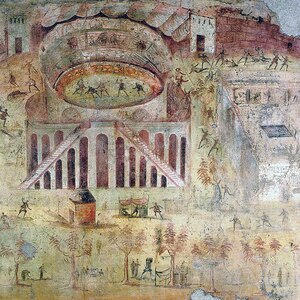Gladiatorial games
Gladiatorial games (ludi gladiatorii) were one of the most famous and dramatic forms of entertainment in Ancient Rome, leaving a significant mark on history and culture. These games not only reflected the Roman passion for spectacle and brutality but also served as an important social and political tool.
 Zliten mosaic from Libya (Leptis Magna). 2nd century AD
Zliten mosaic from Libya (Leptis Magna). 2nd century AD
The origins of gladiatorial games trace back to the funeral rites of the Etruscans, an ancient Italic people. The Etruscans believed that bloodshed would appease the souls of the dead and ensure them peace in the afterlife. The first documented gladiatorial combat in Rome took place in 264 BCE at the funeral of Junius Brutus Pera, where three pairs of gladiators fought at his grave.
Gradually, gladiatorial games lost their ritual function and became mass entertainment. During the late Republic and Empire periods, they evolved into an important element of Roman culture and politics, attracting huge crowds of spectators.
The gladiator games were organized by state officials — aediles and masters. These games served as a means of gaining popularity among the population and were often used for political purposes. The games were sponsored by both emperors and wealthy individuals.
Gladiatorial combats were held in special structures called amphitheaters. The most famous of these is the Colosseum in Rome, opened in 80 CE. This magnificent amphitheater, accommodating around 50,000 spectators, became a symbol of Roman architectural prowess and the brutality of gladiatorial games.
The organization of gladiatorial games was overseen by public officials — aediles and magistrates. These games served as a means to gain popularity among the populace and were often used for political purposes. Sponsors of the games could be emperors or wealthy private individuals. For more information about the types of gladiators and their equipment, see the article about gladiators.
The games began with a parade of gladiators (pompa), where they marched before the audience and swore to fight to the death. The combats could be individual or group battles, sometimes involving animals. Judges in the arena ensured the adherence to rules and decided the outcome of the fight in case of uncertainty.
The fate of the defeated gladiators depended on the audience and organizers. The spectators could shout and gesture, expressing their opinion, but the final decision was made by the emperor or the organizer of the games. There is a common misconception that a thumbs-up signified mercy and a thumbs-down meant death, but historical sources indicate a more complex system of gestures.
Some historians and researchers suggest the following interpretations:
- In his satirical works, Juvenal mentions the gestures of spectators, though he does not provide detailed explanations. In Satire III, 34, he uses the expression "pollice verso": "But the defeated, lying, waits for the heated sword, and the crowd, turning their thumbs, commands him to be killed." This phrase has been interpreted as a gesture ordering the death of the defeated gladiator, but the exact gesture remains unclear.
-In "The Lives of the Twelve Caesars," Suetonius describes how emperors participated in gladiatorial games. He mentions gestures made by the spectators or the emperor himself but does not specify the exact motion of the thumb. The description of "pollice verso" as a gesture signifying death may reflect a later interpretation.
- In one of his letters, Seneca mentions gestures used in the arena but also without detailed description. In his works, Seneca focuses on the moral and philosophical aspects related to gladiatorial games rather than specific gestures.
Among the more recent interpretations are:
Pollice verso: Some modern historians suggest that "pollice verso" might have meant that the thumb was pointed sideways or even upwards, symbolizing a strike. This interpretation is based on later interpretations and cinematic depictions.
Pollice compresso: The possible meaning of a clenched thumb, which might indicate sparing the gladiator, although this gesture is not clearly confirmed in the sources.
Gladiatorial games were used as a means of political influence and a tool for mass control. They provided a distraction for the populace from pressing issues and strengthened the authority of the organizers. The games also served as a demonstration of the emperor's or sponsor's generosity and power.
With the spread of Christianity, gladiatorial games came to be seen as barbaric and immoral. Emperor Honorius officially banned gladiatorial games in 404 CE, although isolated combats might have occurred later. Nonetheless, the popularity of these games gradually waned.
Gladiatorial games remain an important cultural phenomenon, symbolizing the power and brutality of ancient Roman civilization. Today, they continue to inspire art, literature, and cinema, leaving a mark on global culture. These spectacles reflect not only the Roman passion for entertainment but also the complex social and political mechanisms underlying the society of that time.
Related topics
Gladiators, Gladiators-literature, Circus Maximus in Rome, Ancient Rome, Gladiatrix



